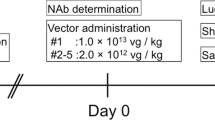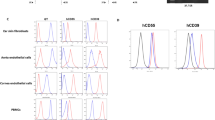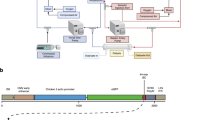Abstract
The naked plasmid DNA transfer method of rapid injection with large volume has been useful for gene therapy in experimental study. However, only small animals like rodents have usually been reported on. In this study, the authors attempted to transfect naked plasmid DNA to the porcine liver by modified hydrodynamic method. We decided to transfer plasmid DNA to a part of the liver using the angio-catheter to reduce the liver damage. To discern the condition of injection, naked plasmid DNA-encoding green fluorescent protein (GFP) was transferred for use as a marker gene. The GFP gene expression was markedly observed in gene-transferred pig livers. In large animals, not only the naked gene quantity, the solution volume containing the plasmid DNA and the injection speed, but also the additional treatments of the portal vein and the hepatic artery preparation were crucial. We found that the following injection condition were needed: plasmid DNA, 3 mg; the solution volume, 150 ml and the injection speed, 5 ml/s. The portal vein and the hepatic artery were clamped during gene delivery and the blood flow of the portal vein was flushed out using normal saline. Cytotoxic T-lymphocyte antigen 4-immunoglobulin (CTLA4-Ig) gene was used to test for secretory protein. CTLA4-Ig gene was injected with a large volume of solution via the hepatic vein to the left outer lobe of the liver selectively. CTLA4-Ig was detected in the pig blood at a maximum serum level of 161.7 ng/ml 1 day after gene transfer, and the CTLA4-Ig was detected for several weeks. Our new technique of inserting a catheter into only a selected portion of the liver reduced liver toxicity and increased gene transfer efficiency. This is the first report of successful gene transfer, using a hydrodynamic method, to the segmental liver in pigs, and achieved more than enough secretory protein for the clinically therapeutic level in pigs.
This is a preview of subscription content, access via your institution
Access options
Subscribe to this journal
Receive 12 print issues and online access
$259.00 per year
only $21.58 per issue
Buy this article
- Purchase on Springer Link
- Instant access to full article PDF
Prices may be subject to local taxes which are calculated during checkout







Similar content being viewed by others
References
Niidome T, Huang L . Gene therapy progress and prospects: nonviral vectors. Gene Therapy 2002; 9: 1647–1652.
Liu F, Song Y, Liu D . Hydrodynamics-based transfection in animals by systemic administration of plasmid DNA. Gene Therapy 1999; 6: 1258–1266.
Zhang G, Budker V, Wolff JA . High levels of foreign gene expression in hepatocytes after tail vein injections of naked plasmid DNA. Hum Gene Ther 1999; 10: 1735–1737.
Maruyama H, Higuchi N, Nishikawa Y, Kameda S, Iino N, Kazama JJ et al. High-level expression of naked DNA delivered to rat liver via tail vein injection. J Gene Med 2002; 4: 333–341.
Liang KW, Nishikawa M, Liu F, Sun B, Ye Q, Huang L . Restoration of dystrophin expression in mdx mice by intravascular injection of naked DNA containing full-length dystrophin cDNA. Gene Therapy 2004; 11: 901–908.
Danialou G, Comtois AS, Matecki S, Nalbantoglu J, Karpati G, Gilbert R et al. Optimization of regional intraarterial naked DNA-mediated transgene delivery to skeletal muscles in a large animal model. Mol Ther 2005; 11: 257–266.
Zhang G, Budker V, Williams P, Subbotin V, Wolff JA . Efficient expression of naked DNA delivered intraarterially to limb muscles of nonhuman primates. Hum Gene Ther 2001; 12: 427–438.
Crespo A, Peydro A, Dasi F, Benet M, Calvete JJ, Revert F et al. Hydrodynamic liver gene transfer mechanism involves transient sinusoidal blood stasis and massive hepatocyte endocytic vesicles. Gene Therapy 2005; 12: 927–935.
Zhang G, Gao X, Song YK, Vollmer R, Stolz DB, Gasiorowski JZ et al. Hydroporation as the mechanism of hydrodynamic delivery. Gene Therapy 2004; 11: 675–682.
Eastman SJ, Baskin KM, Hodges BL, Chu Q, Gates A, Dreusicke R et al. Development of catheter-based procedures for transducing the isolated rabbit liver with plasmid DNA. Hum Gene Ther 2002; 13: 2065–2077.
Zhang G, Vargo D, Budker V, Armstrong N, Knechtle S, Wolff JA . Expression of naked plasmid DNA injected into the afferent and efferent vessels of rodent and dog livers. Hum Gene Ther 1997; 8: 1763–1772.
Herrero MJ, Dasi F, Noguera I, Sanchez M, Moret I, Sanmartin I et al. Mouse and pig nonviral liver gene therapy: success and trials. Gene Ther Mol Biol 2005; 9: 169–180.
Inoue S, Hakamata Y, Kaneko M, Kobayashi E . Gene therapy for organ grafts using rapid injection of naked DNA: application to the rat liver. Transplantation 2004; 77: 997–1003.
Sato Y, Ajiki T, Inoue S, Hakamata Y, Murakami T, Kaneko T et al. A novel gene therapy to the graft organ by a rapid injection of naked DNA I: long-lasting gene expression in a rat model of limb transplantation. Transplantation 2003; 76: 1294–1298.
Sato Y, Ajiki T, Inoue S, Fujishiro J, Yoshino H, Igarashi Y et al. Gene silencing in rat-liver and limb grafts by rapid injection of small interference RNA. Transplantation 2005; 79: 240–243.
Herweijer H, Wolff JA . Progress and prospects: naked DNA gene transfer and therapy. Gene Therapy 2003; 10: 453–458.
Kawabata K, Takakura Y, Hashida M . The fate of plasmid DNA after intravenous injection in mice: involvement of scavenger receptors in its hepatic uptake. Pharm Res 1995; 12: 825–830.
Yang Z, Wu X, Tsui TY, Hou Y, Luk JM, Fan ST . Long-term liver allograft survival induced by combined treatment with rAAV-hCTLA4Ig gene transfer and low-dose FK506. Transplantation 2003; 75: 303–308.
Nakamura M, Wang J, Murakami T, Ajiki T, Hakamata Y, Kaneko T et al. DNA immunization of the grafted liver by particle-mediated gene gun. Transplantation 2003; 76: 1369–1375.
Komiya K, Sato Y, Wainai T, Murayama T, Yamada M, Hiruta A et al. Evaluation of intraoperative infusion solution using a complete anhepatic model in baby pigs. Transplant Proc 2005; 37: 2341–2346.
Ajiki T, Murakami T, Kobayashi Y, Hakamata Y, Wang J, Inoue S et al. Long-lasting gene expression by particle-mediated intramuscular transfection modified with bupivacaine: combinatorial gene therapy with IL-12 and IL-18 cDNA against rat sarcoma at a distant site. Cancer Gene Ther 2003; 10: 318–329.
Hakamata Y, Tahara K, Uchida H, Sakuma Y, Nakamura M, Kume A et al. Green fluorescent protein-transgenic rat: a tool for organ transplantation research. Biochem Biophys Res Commun 2001; 286: 779–785.
Author information
Authors and Affiliations
Corresponding authors
Rights and permissions
About this article
Cite this article
Yoshino, H., Hashizume, K. & Kobayashi, E. Naked plasmid DNA transfer to the porcine liver using rapid injection with large volume. Gene Ther 13, 1696–1702 (2006). https://doi.org/10.1038/sj.gt.3302833
Received:
Revised:
Accepted:
Published:
Issue Date:
DOI: https://doi.org/10.1038/sj.gt.3302833
Keywords
This article is cited by
-
Kidney-specific transposon-mediated gene transfer in vivo
Scientific Reports (2017)
-
Effects of Fibrotic Tissue on Liver-targeted Hydrodynamic Gene Delivery
Molecular Therapy - Nucleic Acids (2016)
-
Human AAT gene transfer to pig liver improved by using a perfusion isolated organ endovascular procedure
European Radiology (2016)
-
Hemodynamics of a hydrodynamic injection
Molecular Therapy - Methods & Clinical Development (2014)
-
Novel electric power-driven hydrodynamic injection system for gene delivery: safety and efficacy of human factor IX delivery in rats
Gene Therapy (2013)



